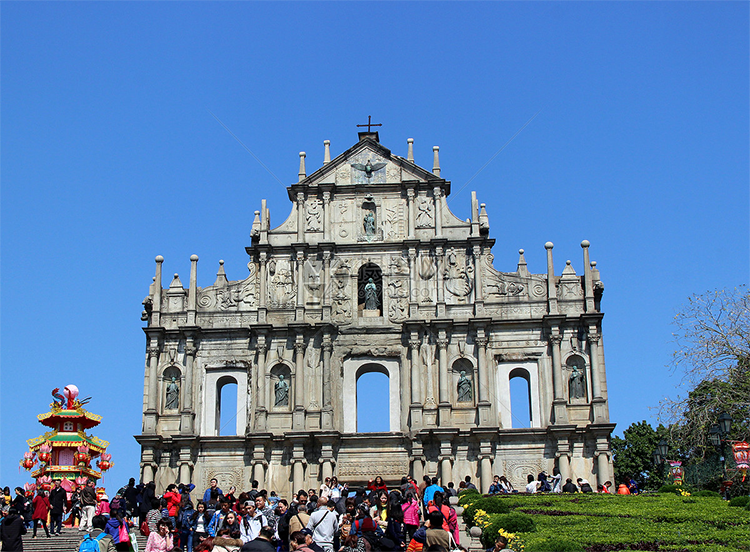Ruins of St. Paul’s: A Macau Heritage Icon Bridging East and West
Ruins of St. Paul’s: Macau’s East-West Heritage
Introduction:
Morning sunlight filters through the intricate stone carvings of the Ruins of St. Paul’s, casting patterned shadows on the square. This towering Baroque facade is not only Macau’s most iconic skyline landmark but also a frozen epic: a 400-year record of Christianity’s arrival in East Asia and a unique example of East-meets-West architecture. Run your hand across the granite reliefs and you can almost hear history’s bells echo.
1. Soul Imprint: A World Heritage Facade and Its Story
Core Feature: A Eurasian religious-art masterpiece forged by fire
Often called Macau’s symbol, the Ruins of St. Paul’s are the surviving front facade of the 16th-century Church of St. Paul. Designed by Jesuit missionaries with Japanese craftsmen involved in its construction, the complex endured three major fires (1595, 1601, 1835). Today its 27-meter-high stone face ranks among Macau’s most celebrated sights. In 2005 the site and the Historic Centre of Macau were inscribed as UNESCO World Heritage, praised as one of the Far East’s finest Catholic art achievements.
Unique selling points:
– Architectural wonder: a rare Baroque church ruin incorporating Asian motifs
– Cultural emblem: a physical testimony to Macau’s Chinese-Western coexistence, with reliefs that pair Chinese characters and Marian imagery
– Religious legacy: early Catholic education center in East Asia, linked to Jesuit scholars and missionaries
2. Five-story Architectural Code: Decoding East-West Dialogue in Stone
Style:
The granite facade is late Renaissance-Baroque in origin, but each of its five tiers hides distinct Eastern influences:
1) Ground level: Triple-arched entrance
– The main lintel bears the Latin inscription MATER DEI (Mother of God); side carving motifs include Japanese chrysanthemum designs
– The step layout reflects local feng shui ideas of gradual ascent
2) Second to fourth tiers: A sculptural theater
– Over 60 bronze-like figures narrate Biblical scenes: the Virgin trampling a dragon (symbolizing triumph over evil), angels, and saints
– Distinct Eastern touches appear in peony patterns, Chinese inscriptions, and guardian stone lions
3) Top crown: Sacred emblem
– A bronze dove symbolizes the Holy Spirit above sun-and-moon motifs that echo Chinese cosmology
– A cross and a Portuguese maritime globe underline the missionary and navigational heritage
Artistic value:
Many carvings are attributed to 17th-century Japanese Christian artisans who adapted European religious narratives into an East Asian visual vocabulary. The image of the Virgin standing upon a dragon is an unusually localized religious motif seldom seen elsewhere.

3. Immersive Experience: From Ruins to Museum Time Travel
Religious events:
– Every December 8, an outdoor Mass for the Feast of the Immaculate Conception takes place before the facade
– Visitors can follow bronze markers of the Via Crucis on the ground to experience the traditional pilgrimage path
The Catholic Museum behind the facade:
– Exhibits salvaged altar pieces, paintings, and artifacts recovered from the burned church, plus replicas of relics associated with St. Francis Xavier
– Highlights include 16th-century paintings of Japanese martyrs and hybrid Sino-European Madonna-and-child icons
4. Local Insider Tips
Best times to visit:
– Sunrise (6:00–7:30): soft light enhances the carvings and crowds are light — ideal for photography
– Evening lighting (19:00–22:00): illuminated silhouette is particularly romantic
Hidden gems:
– A narrow path to the right of the facade leads to a small Nezha temple, offering a striking Taoist-Catholic juxtaposition
– Excavated church foundations at ground level reveal the original footprint and scale
Avoid common pitfalls:
– Avoid visiting at noon when harsh light washes out sculptural detail
– Be cautious of vendors offering “free incense” or aggressive souvenirs

5. Practical Visitor Guide
Basic facts:
– Address: Ruins of St. Paul’s, St. Paul’s Street, Macau Peninsula
– Hours: The facade is accessible 24 hours; the museum is open 9:00–18:00 (closed Tuesdays)
– Cost: Free entry to both the ruins and the museum
Getting there:
– Bus: Routes 3, 3X, 4, 6A, 8A to the ‘Ruins of St. Paul’s’ stop, then a 5-minute walk
– Walk: About 10 minutes uphill from Senado Square via souvenir-lined streets
– Taxi: Tell the driver ‘St. Paul’s’ — drop-off is within 200 meters
Etiquette:
– Photography allowed; flash is prohibited and photography is forbidden inside the museum
– Dress modestly (cover shoulders and knees) out of respect for the site’s religious nature
– Keep voices low to preserve a solemn atmosphere
6. Suggested Itineraries
Half-day cultural route:
Ruins of St. Paul’s → Lover’s Lane with colorful Portuguese facades → Saint Dominic’s Church (beautiful Baroque interior) → Leal Senado Building
Full-day exploration:
Morning: Ruins and museum → Lunch with local dessert double-skin milk pudding at a nearby café
Afternoon: Macau Museum → Mount Fortress for panoramic views → Evening: illuminated ruins tour

Conclusion:
The Ruins of St. Paul’s stand like a stone chronicle, each crack telling Macau’s journey from fishing village to international port. Standing on the steps, you witness a creative encounter between Catholic and Chinese civilizations and feel the enduring pulse of cultural exchange. This ruin reminds us that the most memorable monuments are often those reborn from destruction.


